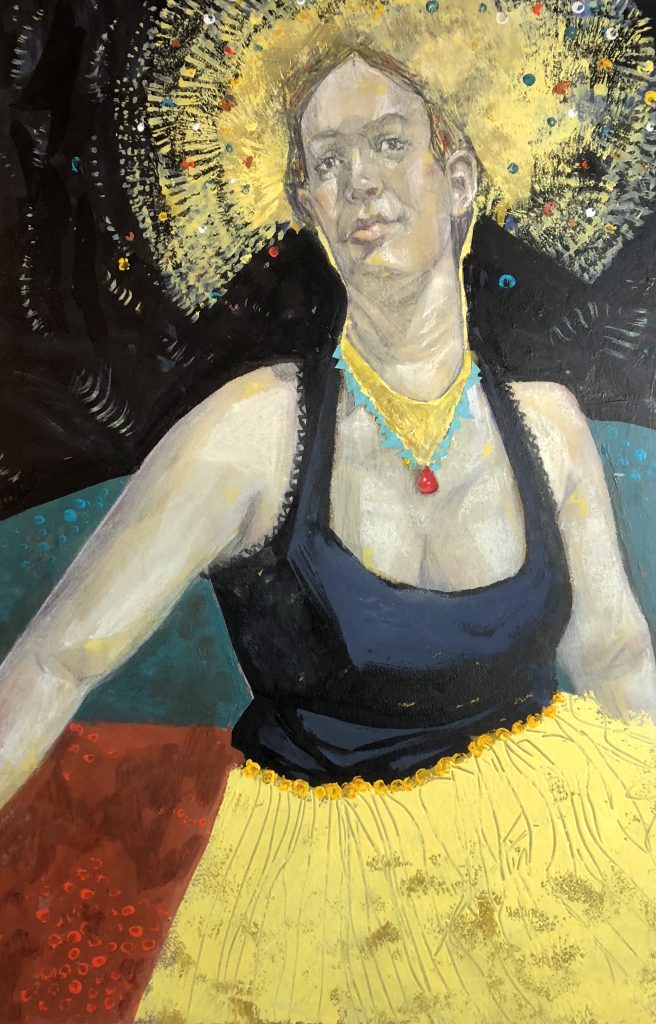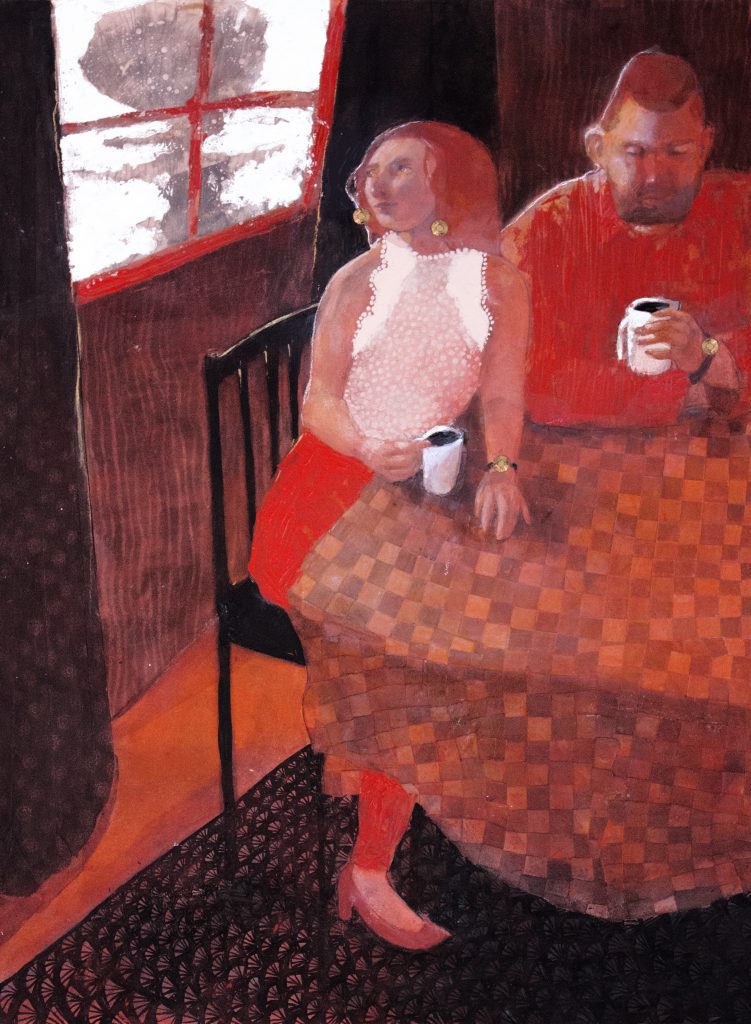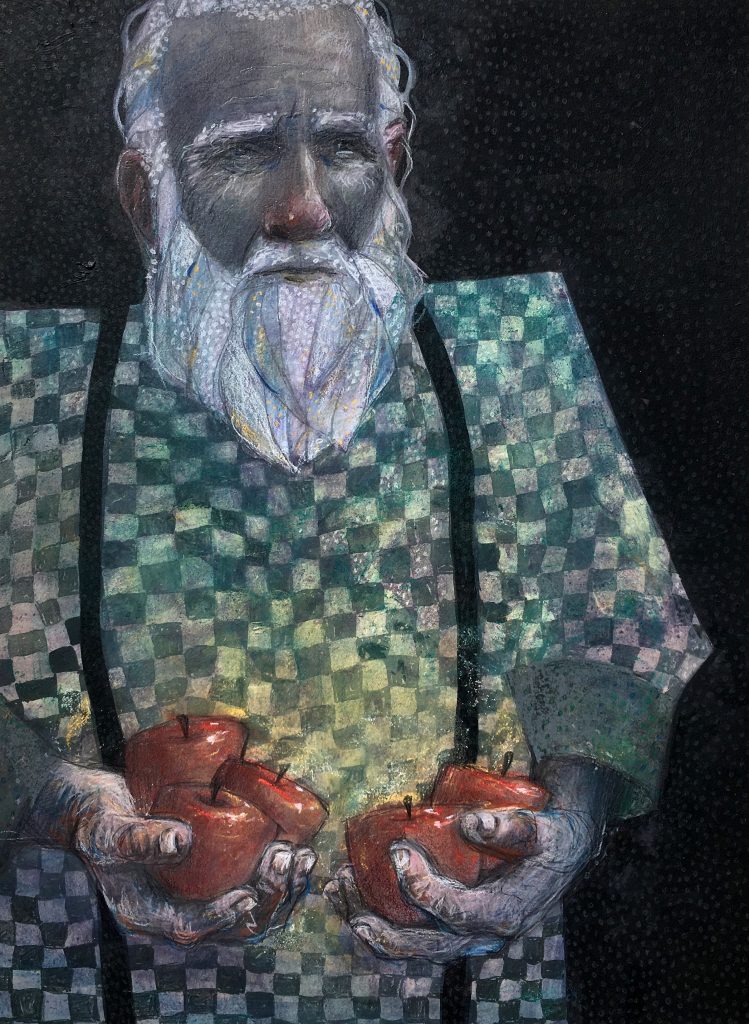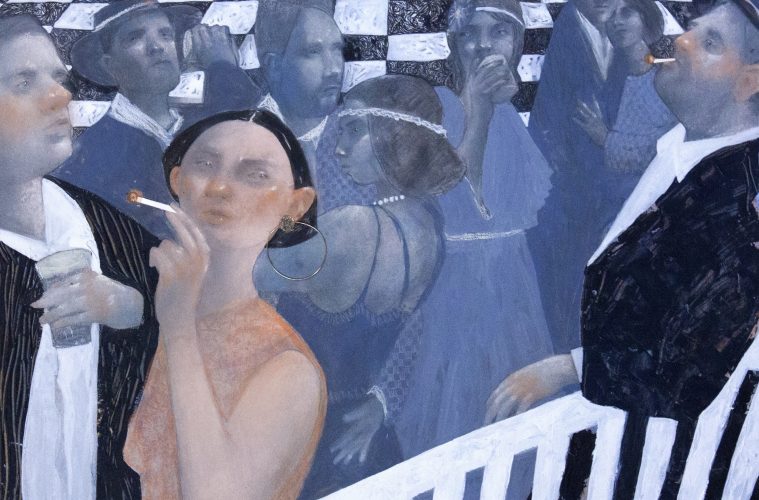The Metropolitan has a habit of finding good up and coming artists. One of the things we do well. Take a look at our archives on Detroit based artists Michelle Tanguay and William Irving Singer, for example; two painters on the scene during the Great Recession who have become pioneers in the Renaissance of the city.
Artist Sheila Nicolin is an illustrator who comes to us by way of CCS (College for Creative Studies). She’s currently holed up in Detroit’s Fisher Building with a few artful co-conspirators hell-bent on bettering the community through shape, form, lines, texture, and color.
We think she has a bright future …

Lemon
Q: You have stated that your paintings are heavily influenced by “storytelling” – what does that mean?
By storytelling, I am paying tribute to my roots in reading and writing. In all of my images, I seek to tell a subtle story or to communicate a mood. From a young age, I was always writing and illustrating my own little storybooks—the most memorable one being about a very adventurous whale. However, I think I have a very unique voice in this story-telling realm of artwork, because my paintings are not distinctly narrative, but seem to communicate a deeper story through symbolism and expression. (I think my love for Steinbeck and Kafka are shining through a bit).
Q: Are you working on anything now that combines writing and illustration?
Right now, I’m working on writing and illustrating a passion project of mine—a middle-grade, illustrated novel. I’ve only completed the first few chapters at this point, but it has been a rewarding experience to combine my two creative pursuits because I feel that reading, writing and drawing are so closely intertwined for me.
My artwork is fueled by experience and knowledge, so this makes me a big proponent of time-deepening. I’m the person listening to some excessively lofty David Foster Wallace audiobook, creating a five-foot tall painting, chewing gum and playing hopscotch. Currently, I’m toggling between re-reading/listening to My Antonia and the backlogs of the podcast, This American Life.
Q: What do you see when you are sitting with a subject? What are you trying to capture or express?
When I sit with a subject, I try to create exciting shapes and patterns through lighting and costuming in order to capture a suggestion of emotion and surrealism. I try to capture moments and moods in subtle and artful ways. Through my model’s expression, posing and environment, I describe a deeper implication of narrative through suggestion, which creates a surreal sense of dream or altered reality within my work.

The Last Night On Earth
Q: Your work does feature geometric shapes with plenty of pattern and texture: Who before you has done this that you admire and how has it influenced your work?
I love the juxtaposition of carefully designed shapes and edges against noise because it combines my passion for beautiful drawing with my love of mark-making and surface development. Within this pursuit, I am inspired both in matters of technique and design by the Vienna Secessionists and the French Post-Impressionists. I also draw large inspiration from Andrew Wyeth, Edwin Dickinson and Jean Dominique-Ingres. More contemporary figures that have employed a similar aesthetic and serve as a huge inspiration to me include Mark English and Gary Kelley. All of these artists mashed together exposed me to the exciting power of pattern and geometry within picture making.
Q: Tell us about The Fox and the Forrest (Featured image). I love how the image begins with full color, very elegant, then turns to shadow before moving into a black and white tiled ballroom. And, the woman with a cigarette …
“The Fox and the Forest” again ties back to my love of literature. I created this image as a visual representation of a short story of the same name from Ray Bradbury’s collection, The Illustrated Man. Set in the 1930’s, this image explores the subtle narrative of pursuit and suspicion within a crowd, as the eyes of all look at one another. In true Ray Bradbury fashion, this image is incredibly quiet, yet undeniably surreal, with the off-putting checkerboard pattern leaving you questioning reality.
Q: So, there is some intrigue, if not politik, embedded within the scene. Does art have a responsibility to society?
That is an undeniable truth, but a subjective one as well. I think a large part of one’s artistic journey is finding your unique voice within your given industrial pursuit through which you can give back to society. This contribution to society may be expressed through an activity as direct as volunteer work or as subtle, but equally powerful, as sharing innovative or forward-thinking images that shape the world around us. Within Detroit, I believe we see this combination of art and society in a very hands-on manner through grassroots murals, community betterment installations and social growth, which I think for me has been incredibly rewarding to witness and experience.

The Giver
Q: What is the climate in the Detroit art scene? How has it evolved over the past 5 years?
The Detroit art scene is undeniably blossoming. This is specifically seen through the repurposing of historic spaces with fresh development. Through the renovation and conversion of post-industrial architecture, our city has been decorated with unique murals through organizations like Murals in the Market. Likewise, I feel so honored to be a current tenant in a part of the Fisher Building that was converted into artists’ spaces. It is inspiring and exciting to be able to interact and inhabit such a monument to both the city of Detroit, as well as to the Art Deco period.
Q: Tell us more about the converted artist space in the Fisher …
This past fall, the Platform, a young real estate development company, began renting renovated studio spaces within the Fisher Building to artists, designers and photographers. Right now, a portion of the fourth floor of the building has been converted into this creative space, and we’re hoping to work toward open studio nights and group exhibitions in the coming months.
The Platform is pouring a lot of effort into revitalizing the New Center area and surrounding Detroit neighborhoods in an effort to build toward the future of the city, while preserving the integrity of Detroit. While nothing is set in stone, my studio mates and I are hoping to work with the Platform in the near future so keep your peepers peeled!
Q: What is missing from the scene that needs to be addressed?
What is missing from our art scene is this: Detroit is not home to a huge number of large-scale art and design-oriented companies; Detroit is not Chicago or L.A. or New York; Detroit is not filled with only advertisement agencies, entertainment tycoons or fashion designers. Instead, Detroit’s art scene is centered around the interconnectivity of independent creative professionals, which I think has greatly contributed to the close and diverse community of designers of all specialties. To me, what most needs to be addressed is that–in this moment of incredible change and progress in our city–we need to preserve this legacy of honest labor and individualism that makes Detroit such a unique platform for art.
Q: In the age of technology what must art do to remain relevant?
In my opinion, art becomes increasingly relevant within the tech age. Technology houses a platform for art to be spread and communicated through international platforms, and provides artists with the necessary tools to infinitely better their craft. Furthermore, visual artists have the advantage of being able to create tangible and tactile objects in an increasingly virtual world. Art is something with which we can interact and experience, through which we can each learn or feel inspired. I think that this adds an extreme amount of value to the relevance of human creation in the modern world.
Q: Finally, I’m curious to discover your favorite crayon in the box when you were a child, and do you still find yourself going back to that color?
Well, to start, I was definitely the kid with the 64-box of crayons; I needed all of the colors! However, I definitely was attracted to blue and green especially, which I see in my work now because I still have a love for cool tones. These colors are reflected in my subject choices as well. As a child, I was very drawn to observing nature: flowers, trees and animals. Today, the blues and greens of nature and organic shapes are very prevalent in my work and use of pattern design.
Look for Sheila Nicolin in the College for Creative Studies Student Show, May 11-25.

